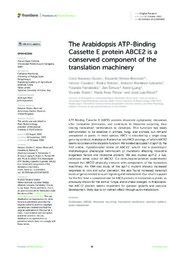Por favor, use este identificador para citar o enlazar este ítem:
https://hdl.handle.net/11000/35314Registro completo de metadatos
| Campo DC | Valor | Lengua/Idioma |
|---|---|---|
| dc.contributor.author | Navarro-Quiles, Carla | - |
| dc.contributor.author | Mateo-Bonmatí, Eduardo | - |
| dc.contributor.author | Candela, Héctor | - |
| dc.contributor.author | Robles, Pedro | - |
| dc.contributor.author | Martínez-Laborda, Antonio | - |
| dc.contributor.author | Fernández, Yolanda | - |
| dc.contributor.author | Simura, Jan | - |
| dc.contributor.author | Ljung, Karin | - |
| dc.contributor.author | Rubio, Vicente | - |
| dc.contributor.author | Ponce, María Rosa | - |
| dc.contributor.author | Micol, José Luis | - |
| dc.contributor.other | Departamentos de la UMH::Biología Aplicada | es_ES |
| dc.date.accessioned | 2025-01-26T10:38:30Z | - |
| dc.date.available | 2025-01-26T10:38:30Z | - |
| dc.date.created | 2022-10-17 | - |
| dc.identifier.citation | Frontiers in Plant Science, 17 October 2022, Sec. Plant Biotechnology, Volume 13 - 2022 | es_ES |
| dc.identifier.issn | 1664-462X | - |
| dc.identifier.uri | https://hdl.handle.net/11000/35314 | - |
| dc.description.abstract | ATP-Binding Cassette E (ABCE) proteins dissociate cytoplasmic ribosomes after translation terminates, and contribute to ribosome recycling, thus linking translation termination to initiation. This function has been demonstrated to be essential in animals, fungi, and archaea, but remains unexplored in plants. In most species, ABCE is encoded by a single-copy gene; by contrast, Arabidopsis thaliana has two ABCE paralogs, of which ABCE2 seems to conserve the ancestral function. We isolated apiculata7-1 (api7-1), the first viable, hypomorphic allele of ABCE2, which has a pleiotropic morphological phenotype reminiscent of mutations affecting ribosome biogenesis factors and ribosomal proteins. We also studied api7-2, a null, recessive lethal allele of ABCE2. Co-immunoprecipitation experiments showed that ABCE2 physically interacts with components of the translation machinery. An RNA-seq study of the api7-1 mutant showed increased responses to iron and sulfur starvation. We also found increased transcript levels of genes related to auxin signaling and metabolism. Our results support for the first time a conserved role for ABCE proteins in translation in plants, as previously shown for the animal, fungal, and archaeal lineages. In Arabidopsis, the ABCE2 protein seems important for general growth and vascular development, likely due to an indirect effect through auxin metabolism. | es_ES |
| dc.format | application/pdf | es_ES |
| dc.format.extent | 17 | es_ES |
| dc.language.iso | eng | es_ES |
| dc.publisher | Frontiers Media | es_ES |
| dc.rights | info:eu-repo/semantics/openAccess | es_ES |
| dc.rights | Attribution-NonCommercial-NoDerivatives 4.0 Internacional | * |
| dc.rights.uri | http://creativecommons.org/licenses/by-nc-nd/4.0/ | * |
| dc.subject | Arabidopsis ABCE2 | es_ES |
| dc.subject | ribosome recycling | es_ES |
| dc.subject | translation machinery | es_ES |
| dc.subject | venation pattern | es_ES |
| dc.subject | auxin metabolism | es_ES |
| dc.subject.other | CDU::5 - Ciencias puras y naturales::57 - Biología | es_ES |
| dc.title | The Arabidopsis ATP-Binding Cassette E protein ABCE2 is a conserved component of the translation machinery | es_ES |
| dc.type | info:eu-repo/semantics/article | es_ES |
| dc.relation.publisherversion | https://doi.org/10.3389/fpls.2022.1009895 | es_ES |

Ver/Abrir:
fpls-13-1009895.pdf
8,59 MB
Adobe PDF
Compartir:
 La licencia se describe como: Atribución-NonComercial-NoDerivada 4.0 Internacional.
La licencia se describe como: Atribución-NonComercial-NoDerivada 4.0 Internacional.
.png)